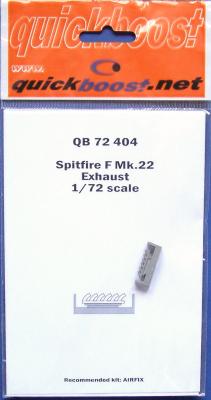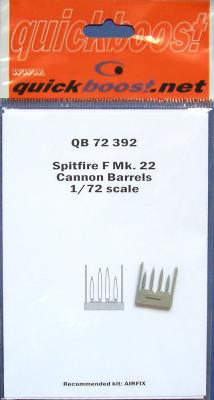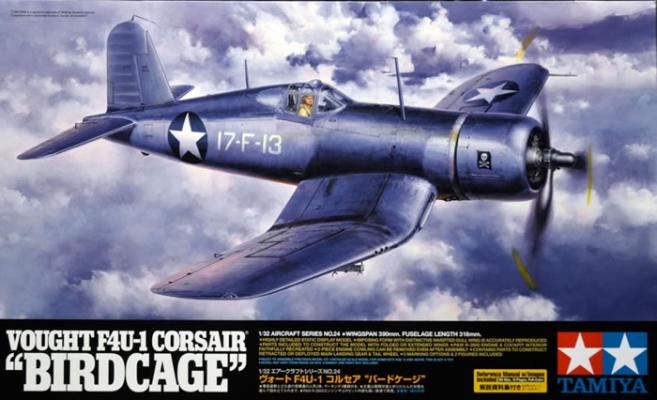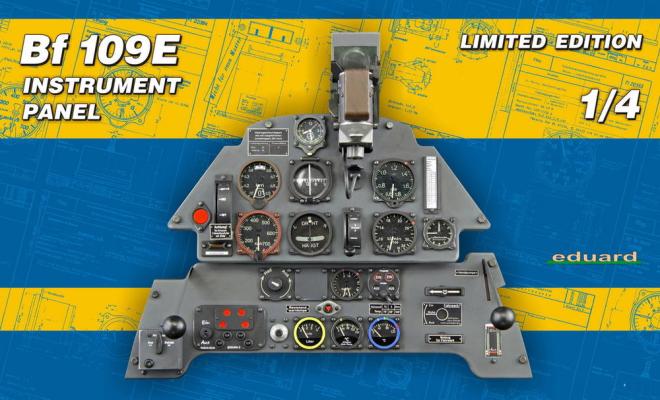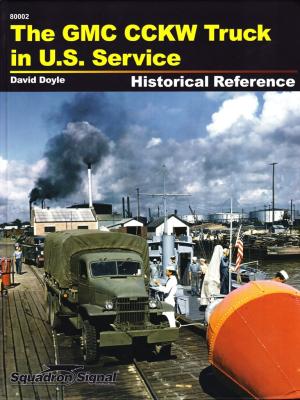The newly released Spitfire F.Mk.22 by Airfix in 1/72 scale is an excellent kit right out of the box. Of course, there is always room for improvement. Quickboost has already given us replacement cannons, correcting the only real deficiency in the kit. Here they offer resin, drop-in replacements for the exhaust stacks. What's the advantage of these? These resin exhausts closely mimic the shape of the kit parts, which look accurate to me. However, the Quickboost replacement parts have the holes already in them, saving the modeler the task of trying to place a dozen symmetrical holes in very small rods. The thickness of the exhaust stack walls appears to be in scale. Also, there are no seam lines to deal with in the resin parts, but they are present on the kit parts. Basically, the Quickboost exhaust will save you time and present a more realistic appearance than the kit parts. Moreover, these benefits come at a very reasonable price.
Welcome to the IPMS/USA Reviews site!
Introduction: The primary organization of the IPMS/USA Review website is by IPMS/USA National Contest Class. Within each Class there are sub-menus by kits, decals, books, etc. The Miscellaneous Class is for items that are not class specific or that cross two or more classes.
IPMS/USA Members: We encourage you to submit reviews, both here and to the Journal. To volunteer for membership in the IPMS/USA "Reviewers Corps" and submit your own reviews, please read the Guidelines For Submitting Product Reviews.
Manufacturers, publishers, and other industry members: IPMS/USA is pleased to offer your company the opportunity for product reviews. All product reviews are performed by IPMS/USA members, and are posted in the publicly-accessible section of our website. With very few exceptions, we perform full build reviews of new kit releases, aftermarket products, and supplies. If you would care to provide product samples for review, please contact John Noack, IPMS/USA 1st VP.
To learn more about IPMS/USA, please see our About Us page.
One of the criticisms I've read about the 1/72 scale Airfix Spitfire Mk.22 is the cannons are not quite the right shape or length. Apart from this deficiency, the Airfix Spitfire is an excellent kit and a great value for your money.
If you want to improve this model's looks and accuracy, however, Quickboost has a remedy. Their replacement resin cannons are drop-ins for the original kit pieces. Based on photos I saw, they capture the shape and size of the real thing. The kit's outboard cannons are too short, both barrels seem too bulbous, and both have an out of scale extension on the tip. Also, the resin replacements have no seam lines to eliminate – a definite plus, since the kit parts have large sprue gates. Smoothing out these sprue attachment points presents the possibility of deforming the circular barrels. Overall, the Quickboost cannon barrels look more refined and in scale. Check out the photos to see what I mean.
After the last segment, the kit was ready for paint. There are three marking options included in the kit. I chose a tri-color screen from VF-17 aboard the USS Bunker Hill in 1943. To start painting, I wanted the bottom white to be hard and take some weathering. For this, I used decanted Tamiya lacquer from a spray can. This is just one of the many tricks I learned from Ed Kinney. I masked off the exhausts with Silly Putty and used a little red brown (just a couple drops) to tint the white away from pure white. This was sprayed in three coats and left to dry. The lacquer dried very quickly and very hard. At this time, the landing gear and the gear doors, the main flaps, and a bunch of miscellaneous parts were sprayed.
The Bf-109E instrument panel is the second instrument panel released by Eduard, the first being the Bf-110 panel. The kit consists of eighty five plastic parts on two grey-colored sprues, one clear sprue, two photo etch frets (one colored), and one decal sheet.
The construction sequence starts off with the Revi C/12D gunsight. Let me tell you, this is a kit in itself. The build is pretty straightforward. You just have to pay attention to the instructions. I put one PE piece on upside down and had to remove it and reattach it.
This is the second book to be released by Squadron Signal Publications under the "Historical Reference" series. As explained in the front of the book, this series is written by using in-depth research of primary documents, giving a very detailed look at the subject matter. It appears that there may other books in the works covering aircraft and vessels. As I have said before, in my opinion this book is like a Walk Around or In Action series book on steroids.
The book starts with the origins of the CCKW. This began in 1928 when the U.S. Army Quartermaster Corps started developing its standard fleet. What came from this were two 2-1/2 ton 6x6 vehicles. One of the interesting names involved in its development is a major player – John D. Hertz. Yes, of the rental car company, but he first owned Yellow Cab, and then Yellow Coach Manufacturing Company, which ended up merging with GM. They were instrumental in the development of the CCKW.











